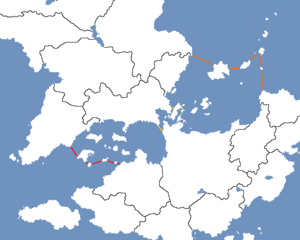User:Planita13/Sandbox3: Difference between revisions
mNo edit summary |
No edit summary |
||
| Line 1: | Line 1: | ||
[[File:Asterian Gates.png|300px|thumb|right|A map of the four "gates" of the Arucian as proposed by [[Debi Brocardi]]:<br> | |||
{{*}}{{Color box|#ec1c24|border=darkgray}} [[Sainte-Chloé]]-[[Carucere]]<br> | |||
{{*}}{{Color box|#ff7f27|border=darkgray}} New Aurean<br> | |||
{{*}}{{Color box|#22b14c|border=darkgray}} Arucian [[Satucin]]<br> | |||
{{*}}{{Color box|#fff200|border=darkgray}} [[Île d'Émeraude]]]] | |||
The '''Arucian Gates''' is a {{wp|History|historical}} and {{wp|geography|geographical}} theory developed by [[Carucere|Carucerean]] historian [[Debi Brocardi]] to refer to the {{wp|Maritime transport|maritime}} {{wp|Choke point|choke points}} of the [[Arucian Sea]], and their importance in Asterian history. She first outlined her theory in the 2002 article "''A Brief History of the Arucian Sea''" before expanding upon it in the 2005 article "''The Gates of Great Sea''". | |||
| | |||
| | |||
| | |||
| | |||
| | |||
| | |||
| | |||
| | |||
| | |||
| | |||
| | |||
}} | |||
The theory highlights four major "gates", maritime choke points, of the Arucian which allows those who controlled land adjacent to the "gates" to wield control over these waterways and the maritime traffic within it. The four gates are the waterways between [[Sainte-Chloé]] and [[Carucere]] and the mainlands, the New Aurean Strait, the islands of Arucian [[Satucin]], and the waterways north and south of [[Île d'Émeraude]]. People have used them to control, secure, or restrict oceanic travel not only within their "gate", but across the wider Arucian Sea. In her original work, Brocardi provided several examples of this from the West Arucian trade network in the pre-colonial era, to piracy in the West Arucian during the 17th century, and the battles for naval control of the Arucian during the [[Great War (Kylaris)|Great War]] and the [[Solarian War]]. | |||
Revision as of 20:30, 18 August 2022

• Sainte-Chloé-Carucere
• New Aurean
• Arucian Satucin
• Île d'Émeraude
The Arucian Gates is a historical and geographical theory developed by Carucerean historian Debi Brocardi to refer to the maritime choke points of the Arucian Sea, and their importance in Asterian history. She first outlined her theory in the 2002 article "A Brief History of the Arucian Sea" before expanding upon it in the 2005 article "The Gates of Great Sea".
The theory highlights four major "gates", maritime choke points, of the Arucian which allows those who controlled land adjacent to the "gates" to wield control over these waterways and the maritime traffic within it. The four gates are the waterways between Sainte-Chloé and Carucere and the mainlands, the New Aurean Strait, the islands of Arucian Satucin, and the waterways north and south of Île d'Émeraude. People have used them to control, secure, or restrict oceanic travel not only within their "gate", but across the wider Arucian Sea. In her original work, Brocardi provided several examples of this from the West Arucian trade network in the pre-colonial era, to piracy in the West Arucian during the 17th century, and the battles for naval control of the Arucian during the Great War and the Solarian War.